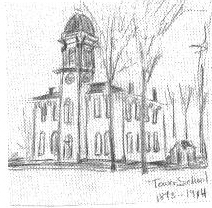

A Short History of Dayton, Indiana
Dayton, Indiana, is a small town with a long history. Native peoples preceded the white settlers, building a town called the Wyandott village at a site a few miles to the south in the center of Richardville Reserve. European settlement began in the early 1820s.
At the time of white settlement, a trading post was located at the Wyandott village. After a mill was built, a settlement sprang up that was eventually platted as Wyandott.
The first settlers came to Dayton from the Connorsville-Noblesville-Strawtown area of Indiana in 1825. William Bush divided part of his land into lots about 1827. Bush and Dr. Timothy Horram filed adjoining town plats on the same day in 1829. Then a few years later David Gregory filed a third plat, and the combined town took the name of Dayton after the principal town in the area of southern Ohio from which many of the settlers came. Gregory donated a lot for a town school.
The town probably began as a market place for the people on the surrounding farms. Storekeepers were among the earliest settlers. Very quickly, however, the town acquired a number of small industries. A sawmill and then a gristmill were built. Coopers, broommakers, and chairmakers settled here. Wagon makers set up shop. After the Civil War, artisans arrived from Pennsylvania who set up a carriage factory that became one of the principal employers in town. The business carried on until the early 1900s, and for a time a car dealership operated. Then in the late 1980s in the fields west of town a car plant was built, the modern incarnation of the transportation industry that has made its home in the town all these years. Today most people work in Lafayette or elsewhere.
There were four churches in town: Presbyterian, Methodist, United Brethren, and Universalist. For a time the Baptists met in the Presbyterian church building. Two churches remain: the United Methodist church south of town and the Presbyterian church on Walnut Street.
Education was important to the early settlers, who soon opened schools in their homes. In the 1820s and 1830s one-room district schools began to operate. In 1859, Dayton Union Seminary (later Dayton ME Academy) opened its doors. It closed in 1872 when the township high school was built. In the fall of 1965 that school became an elementary school, and high school students and, later, junior high students were bused to the schools of Tippecanoe County School Corporation south of town.
One of the first undertakers in the state began an undertaking business in Dayton about 1850. There were two hotels and a livery stable in town, and several restaurants at various times. Folks from Lafayette used to travel to Dayton to spend a day in the country. In the winter they could come in a sleigh known as the Red Bird.
At the time of Civil War, many of the men joined the 72nd Rgt. Ind. Vol. Inf. (later part of Wilder's Lightning Brigade of Mounted Infantry). Others fought with Company A of the 40th Rgt. Ind. Vol. Inf., and several died at Kennesaw Mountain. Still others formed part of the 10th, 86th, 150th, and other regiments of infantry, and the 10th and 18th Batteries Light Artillery. Many of those left at home rushed to Indianapolis when word of Morgan's raid across southern Indiana came, leaving the women and neighbors to harvest their crops. One day townsfolk whispered a rumor that Morgan had reached Romney and was headed this way, but it turned out to be only that.
Transportation to the area in the earliest days was by overland trail or water. Later, roads were built and gradually improved. In 1875 the railroad came to town with a flourish, welcomed by the townsfolk with a parade, a band, and a community dinner. The town has always been near the north-south route from Chicago to Cincinnati or Louisville and points south. The exact location has shifted as new roads were built, but the direction has remained the same. In 1823 the north-south route was the trail that would eventually be named the Newcastle Road, leading from Strawtown to Lafayette. Then it was the Indianapolis-Lafayette Pike, which was eventually paved and named US 52. Now it is Interstate 65, which arrived in 1971 and passes through the west edge of town on its way from Indianapolis to Chicago.
The Wildcat Valley to the east and Wildcat Prairie to the west provided all the necessities for a town to grow. When eventually a church with a steeple was built, the sound of the bell could be heard far out across the prairie. The cardinal, the state bird, is a frequent visitor at backyard feeders in town. It must have been here to greet the first settlers, whether Native Americans or Europeans. The grove of walnut trees on the site of Dayton would have been as welcome a refuge in 1825 as it is today.
©2000-2005 Susan Yost Clawson
All Rights Reserved
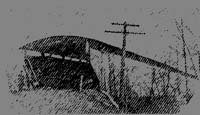
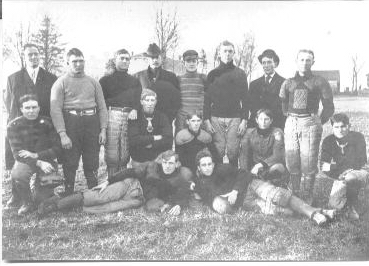
Dayton Covered Bridge, replaced 1916; Dayton Football Team, early 1900s; Elliott School, south of Dayton, 1890s
Fancher's Acre, in the middle of town; Town Christmas Tree; Dayton Town Hall; Dayton Post Office, all from 2008
Dayton Historic District
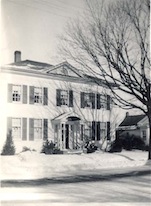
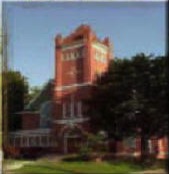
Yost Baker House, built 1847, Dayton Memorial Presbyterian Church, 1899; plaque on town hall building
The Dayton Historic District was approved in 2003. Read about it on the National Register. The National Register of Historic Places now seems to be under the National Parks Service. They are updating their database, but this page lists Dayton: http://www.nps.gov/history/nr/listings/20030404.htm. The info below is copied from their previous database:
Dayton Historic District
(added 2003 - Tippecanoe County - #03000142)
Roughly bounded by Walnut, Harrison, and Pennsylvania Sts., Dayton
(100 acres, 82 buildings)
Historic Significance: Architecture/Engineering
Architectural Style: Greek Revival, Late Victorian
Area of Significance: Architecture
Period of Significance: 1825-1849, 1850-1874, 1875-1899, 1900-1924, 1925-1949, 1950-1974
Owner: Private, Local Gov't
Historic Function: Commerce/Trade, Domestic, Funerary, Religion
Historic Sub-function: Mortuary, Organizational, Religious Structure, Secondary Structure, Single Dwelling, Specialty Store
Current Function: Commerce/Trade, Domestic, Funerary, Religion
Current Sub-function: Mortuary, Organizational, Religious Structure, Secondary Structure, Single Dwelling, Specialty StoreI know that this status was applied for because in 2002 the Wabash Valley Trust asked me to talk to them about the houses in the town and help with the application. I answered questions about some of the houses, including the Baker-Yost house at 740 Walnut Street, where I was living at the time. Other significant old homes would be the Crouse House (1859), the Paden-Russell House (1864), and other homes from the 1830s and 1840s, as well as the 1910 store/bank building (now the town hall), the 1905 Widmer drug store, the Presbyterian Church (1899), and the funeral home (1930s). They asked what significance the area had besides the examples of old architecture. I told them that I believed it was on the path of migration into the area at the time of settlement. The first settlement in the township (which was one of the earliest in the county) was at Wyandott, to the south, and soon after spread to the Dayton area, as well. People came through here also on their way to Clinton and Carroll counties.
I have found the distinction listed on line as granted March 26, 2003, even though no local announcement has ever been made of it. As they widen the highway, I hope the historic status of the area is being kept in mind.--Susan
Local History Links (Open in a new window)
Family Genealogy Links
Family Links
Purdue University Links (Open in a new window)
Other Links (Open in a new window)
Local History (Opens in a new window)
My address is: http://web.ics.purdue.edu/~clawsons/
Susan Y. Clawson <clawsonsy@hotmail.com>
Last updated May 28, 2015.